TREATMENT PROGRESS OF NON-HEALING LEG ULCER WITH UNIQUE APPROACH
Results of an on-going case study from Christine Talbot, Lymphoedema and Bowen Practitioner
N.B Detailed narrated with photographs included below
Background
A lady in her seventies presented with a small leg ulcer just above her left lateral malleoli, it was quite deep, moist and with a faint familiar odour, this was a repeat injury ironically occurring in exactly the same spot and caused in exactly the same way as a previous ulcer some years ago. Whilst gardening a stick went into her ankle, her circulation around the area is poor having had varicose vein surgery, although the injury occurred in October, it failed to heal and worsened over the weeks, District Nurses had been treating it twice weekly without success.
Unfortunately, whilst Christmas shopping in December Mrs P fell in the street fracturing her right femur. Following a pin and plate repair, she was discharged from hospital on crutches but did not receive any physiotherapy. Very quickly, the right leg swelled and became very stiff impeding mobility, which had already been affected by the ulcer on the left leg. Mrs P became very depressed by the pain in both legs, her increasing inability to move and in particular the ulcer which was deepening and spreading, causing great anxiety.
Treatment Protocol

Each of my patients are first clinically evaluated and then I employ the use of four specific medical modalities in a protocol which I have 'tried and tested' over the years and which have shown to be collectively, the most beneficial.
With Mrs P, I chose the treatments according to the ulcer presentation on the day of appointment, or to her feedback. Generally I used a mixture of cold laser, magcell and deep oscillation.
In contrast to externally applied, mechanical forms of therapy, (e.g. vibration), the therapy effect of DEEP OSCILLATION® takes place in the tissue itself and works through the entire depth of the tissue layers (skin, connective tissue, subcutaneous fat, muscles, blood and lymph vessels)
DEEP OSCILLATION® helps in speeding up and improving wound healing processes. Through the oedema-reducing and anti inflammatory effect, the local metabolic elimination and alimentation is improved in all tissue layers, whereby tissue regeneration and wound closure are encouraged on many levels. This is documented by the significant improvement in planimetric and biochemical parameters of the wound healing.
Magcell Information
Magcell Microcirc is a hand held device, based on pulsed electromagnetic field therapy (PEMF) which permeates a 3-5 cm depth and is proven to encourage and increase blood flow to the area (Funk et al, 2014):
“MAGCELL MICROCIRC significantly increases micro-circulation (p < 0,001) while nitric oxide (NO) has a blood vessel dilatory effect. The application of the rotating MagCell-SR to the HUVEC cultures leads to a rapid onset and a significant increase of Nitric Oxide (NO) release after 15 minutes. Thus, frequencies between 4 and 12 Hz supplied by the device improve microcirculation significantly. Therefore, this device can be used in all clinical situations where an improvement of the microcirculation is useful like in chronic wound healing deficits.”
Low level laser therapy (LLLT) Information
"Low level laser therapy (LLLT) is the use of low energy laser light in injuries and wounds in order to improve wound healing, reduce inflammation and alleviate pain. The laser light is monochromatic, coherent and in the red or near infrared spectrum (600 nm – 1000 nm). It is applied at low power density (1 mW to 500 mW/cm2) (“low energy laser”).
In contrast to other medical laser applications LLLT is not a thermal method (i.e. surgical lasers), but produces photochemical effects in the tissue in a similar way to photosynthesis in plants. LLLT is simple to use, effective and cost-efficient and free of side effects. Treatment takes a few minutes and depending on the indication is repeated at longer or shorter intervals and in accordance with healing success. The success of LLLT is based on the following general action principles: tissue regeneration, inhibition of inflammation, alleviation of pain, improvement in circulation, reduction in swelling" Low-Level-Laser-Therapy (LLLT) in Chronic Wounds - Ludwig-Maximilian University Munich, Germany
27th January 2021
Treatment commenced by cleaning the ulcer and drying the area with a red pen cold laser. The Magcell Microcirc was laid over the area to aid and increase blood supply and the Quantum Wave Laser was used in conjunction on a Capillary setting. Mrs P tolerated Deep Oscillation all around and over the ulcer and was greatly encouraged by the end of the treatment, as the ulcer had visually diminished in size, dried and the odour had disappeared.
Mrs P was instructed on how to effectively mobilise her foot and ankle as the Achilles and lower leg were very stiff. She was shown how to manage the ulcer and moisturise her skin daily and to massage behind her knee to encourage drainage up the lower leg.
1st February 2021
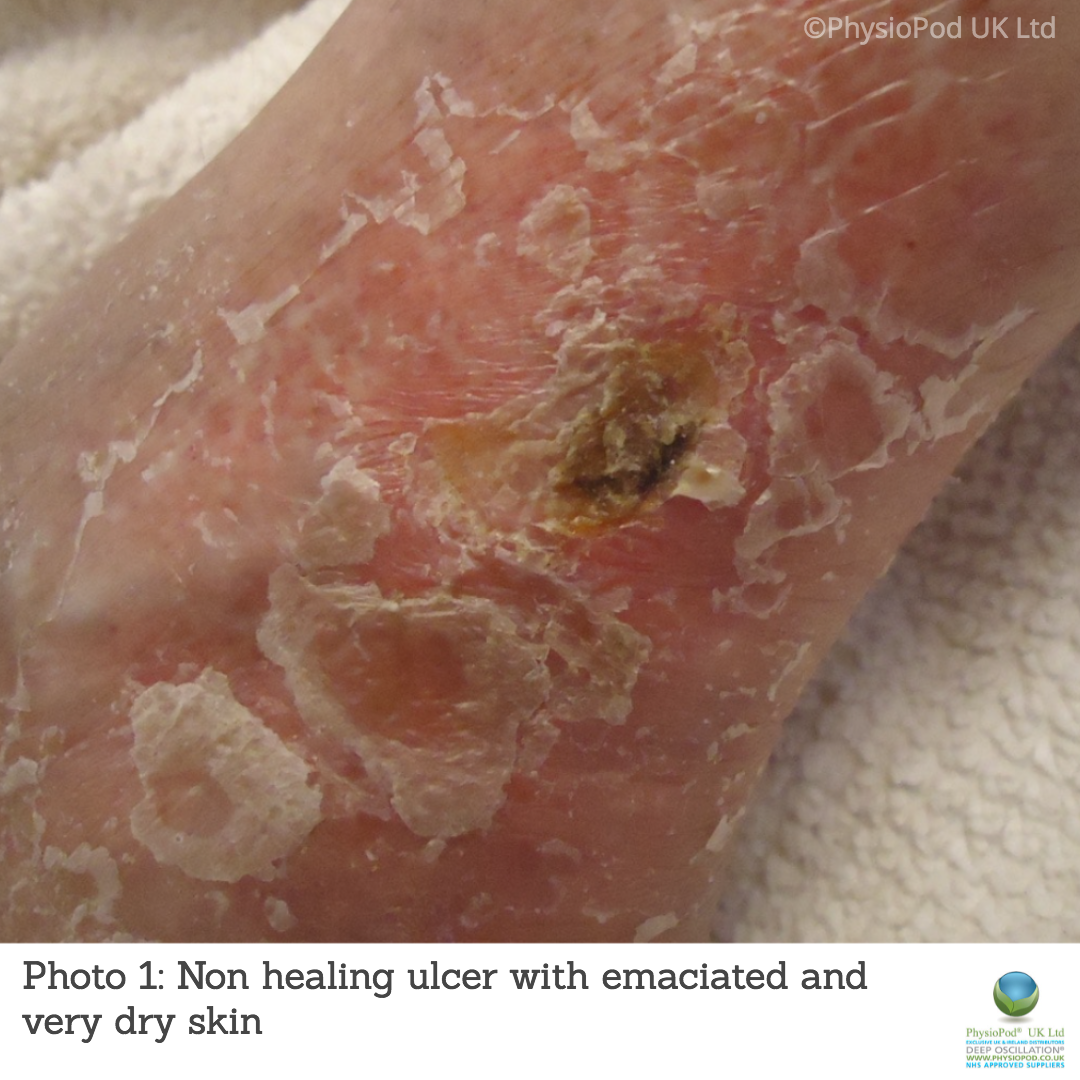
The ulcer had further decreased in size with only slight seepage and the lower leg and foot were mobilising well. Ulcer treatment was repeated with good effect. The scarring on the right leg from the fracture repair was raised, reddened, painful and lumpy and the swollen leg very stiff and immobile. This greatly hindered Mrs P’s mobility and undermined any confidence in her recovery. Deep Oscillation was applied to the whole leg at varying Hz, which was well tolerated and made the limb feel more comfortable, Mrs P found it easier to manoeuvre off the couch and said the fractured leg felt much better. She was shown how to do hamstring stretches and curls to mobilise her swollen knee and to perform the same foot and ankle exercises as the left leg.
15th February 2021
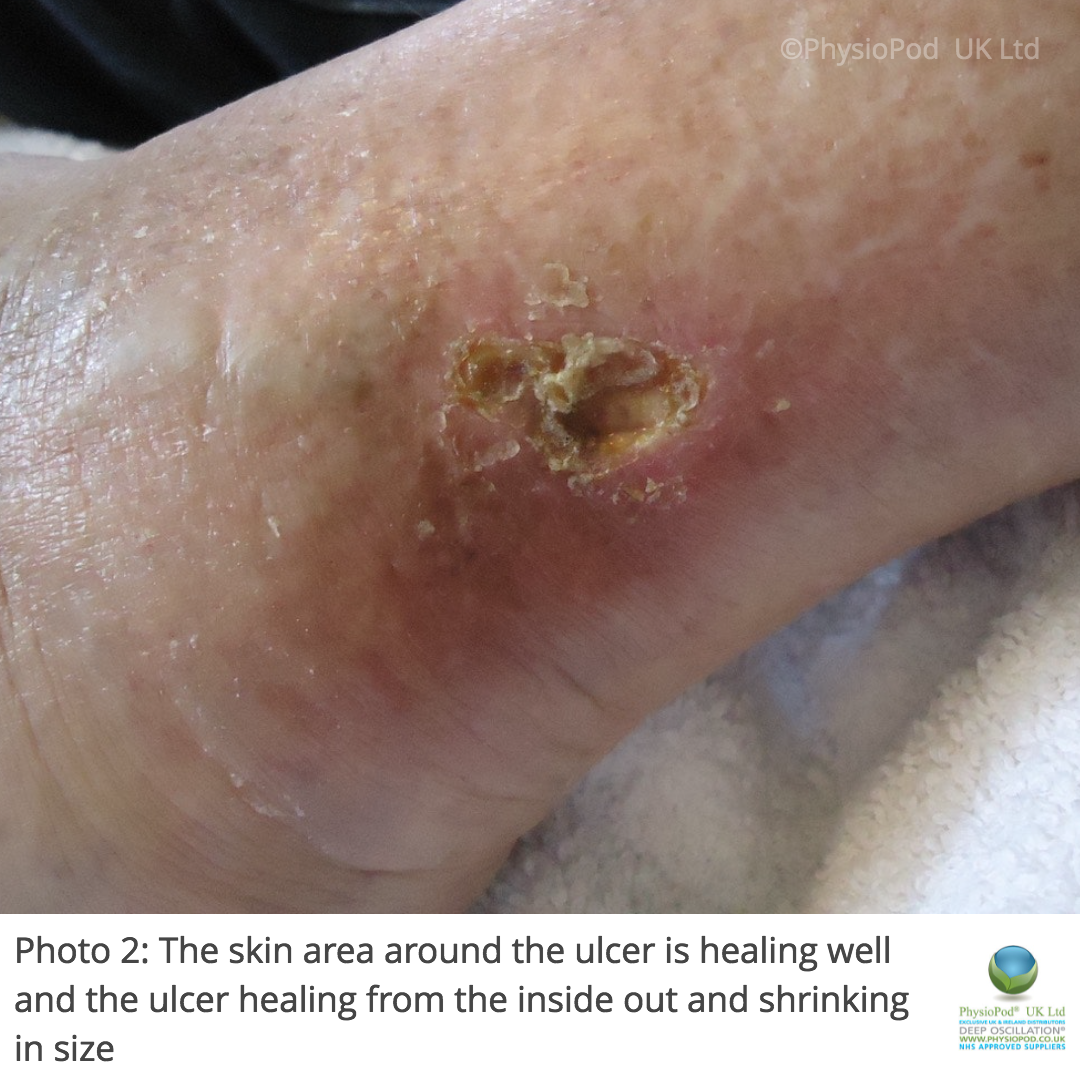
Weekly treatments continued with positive incremental changes each visit. Mrs P was significantly confident by late February to only be reliant for support on a single crutch. She was very diligent with her exercises and her overall mobility was markedly different from her first visit, when she could barely move with two crutches.
8th March 2021
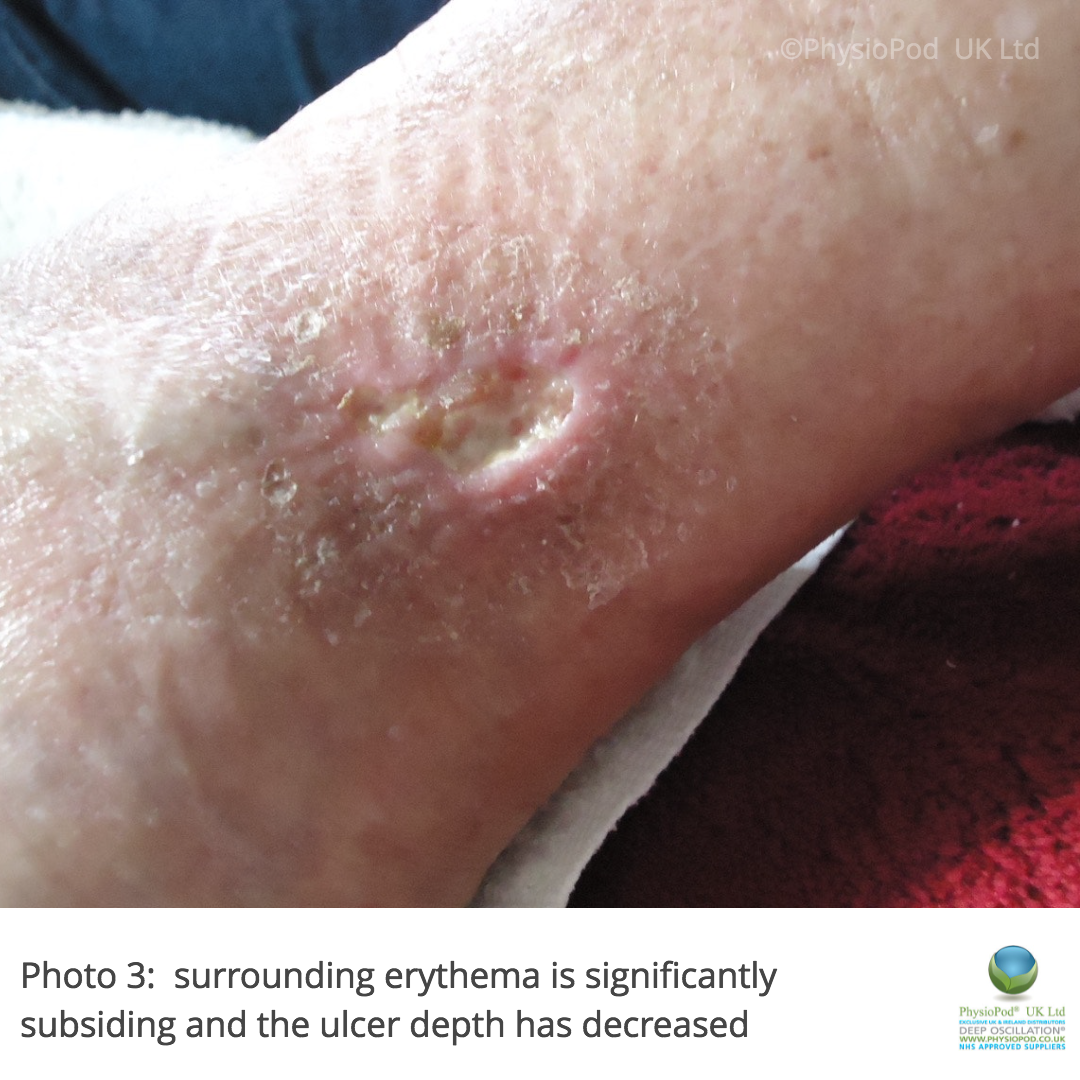
By March the ulcer was very surface, healthy in appearance and reddened in the centre, suggestive of a blood supply to the area. The left Achilles had more ‘play’ in it and Mrs P was shown how to best mobilise the muscle and drain down the back of the lower leg using a Bowen technique with her hands. The right femoral scar was fading but the bone was still painful, Mrs P found deep oscillation over the scar and all the thigh area very soothing. I explained bones are often super sensitive after a fracture.
In mid March all was progressing well with both legs, but at one visit the left ankle area appeared uncharacteristically reddened and warm although Mrs P was non febrile with no ill effects. I advised her to contact her GP for a course of prophylactic antibiotics (flucloxacillin) to suppress any development of Cellulitis. By the following week the antibiotics had prevented infection, although the skin was very dry, inhibiting regular ankle rotations and making the surface ulcerated area very sore as the skin was becoming cracked around the whole ankle. Mrs P felt she wanted to give it a good soak in water to soothe it, as the ulcer was closed I thought it might be beneficial in some cooled boiled water but to dry the area thoroughly with a hairdryer afterwards.
21st April 2021
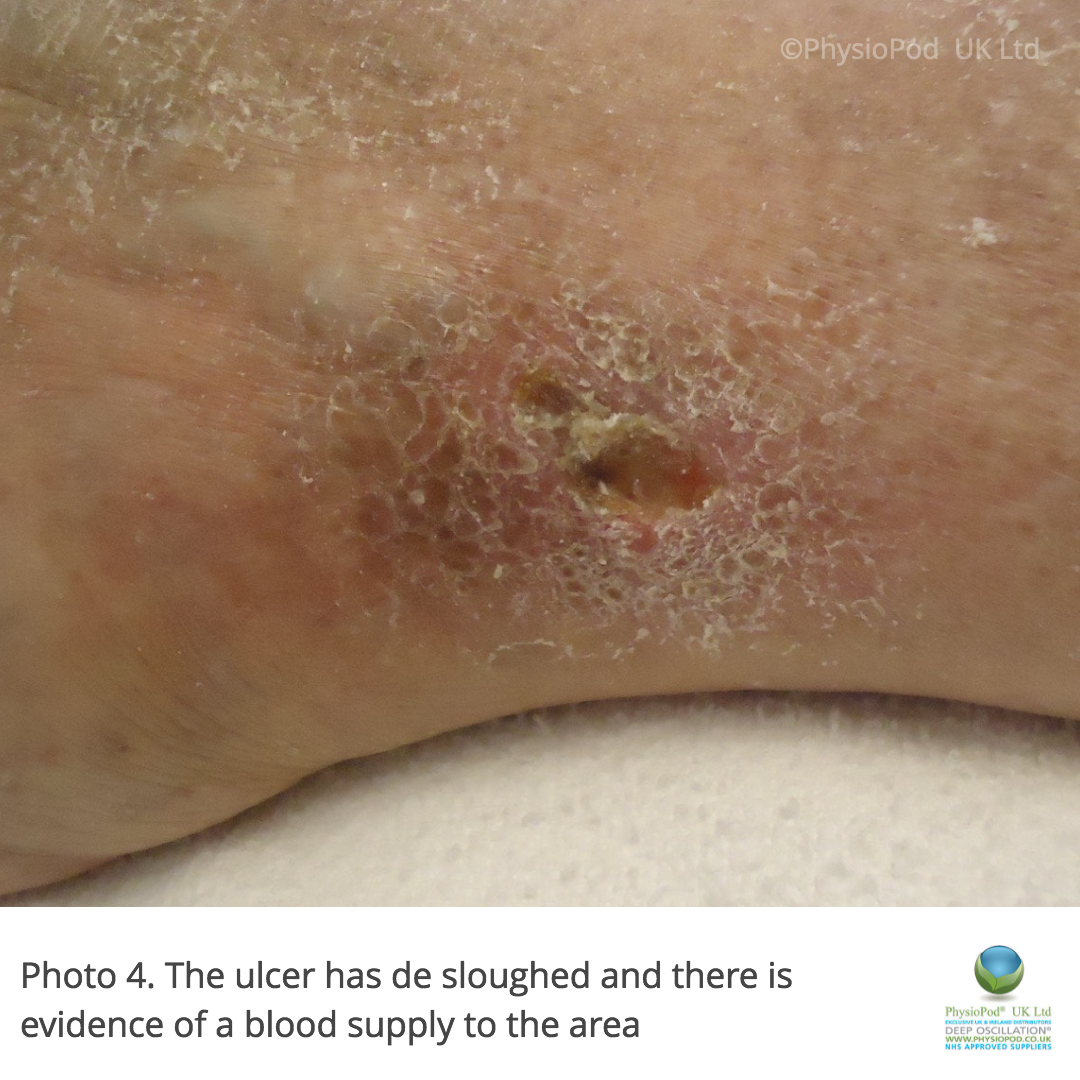
18th May 2021
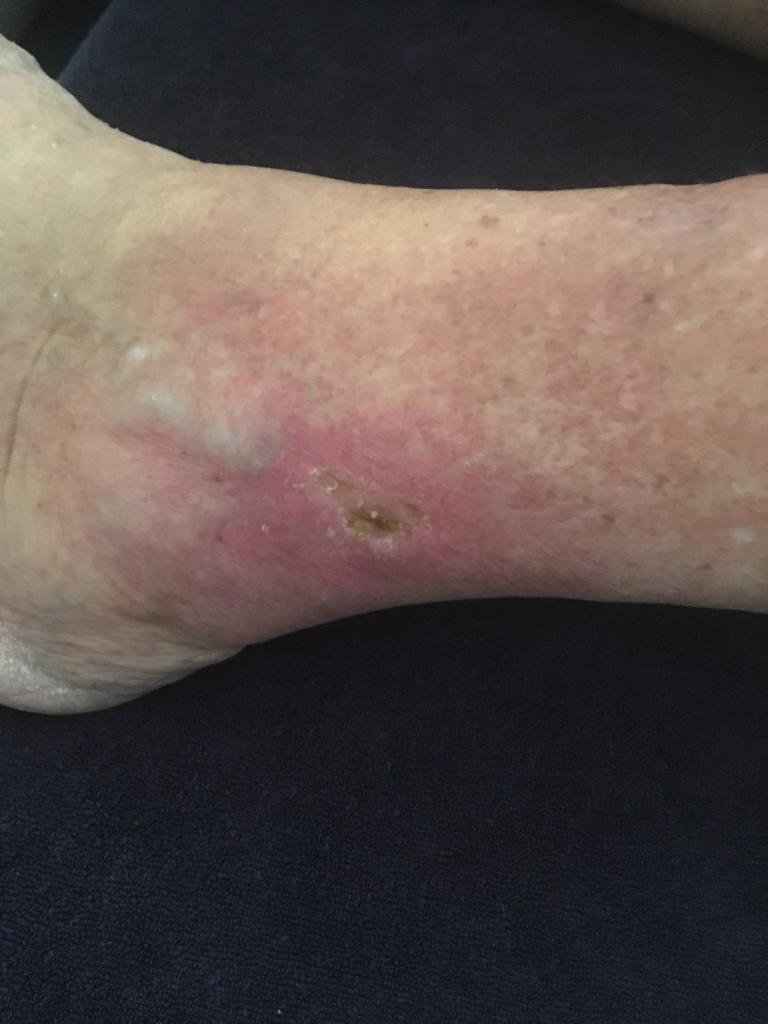
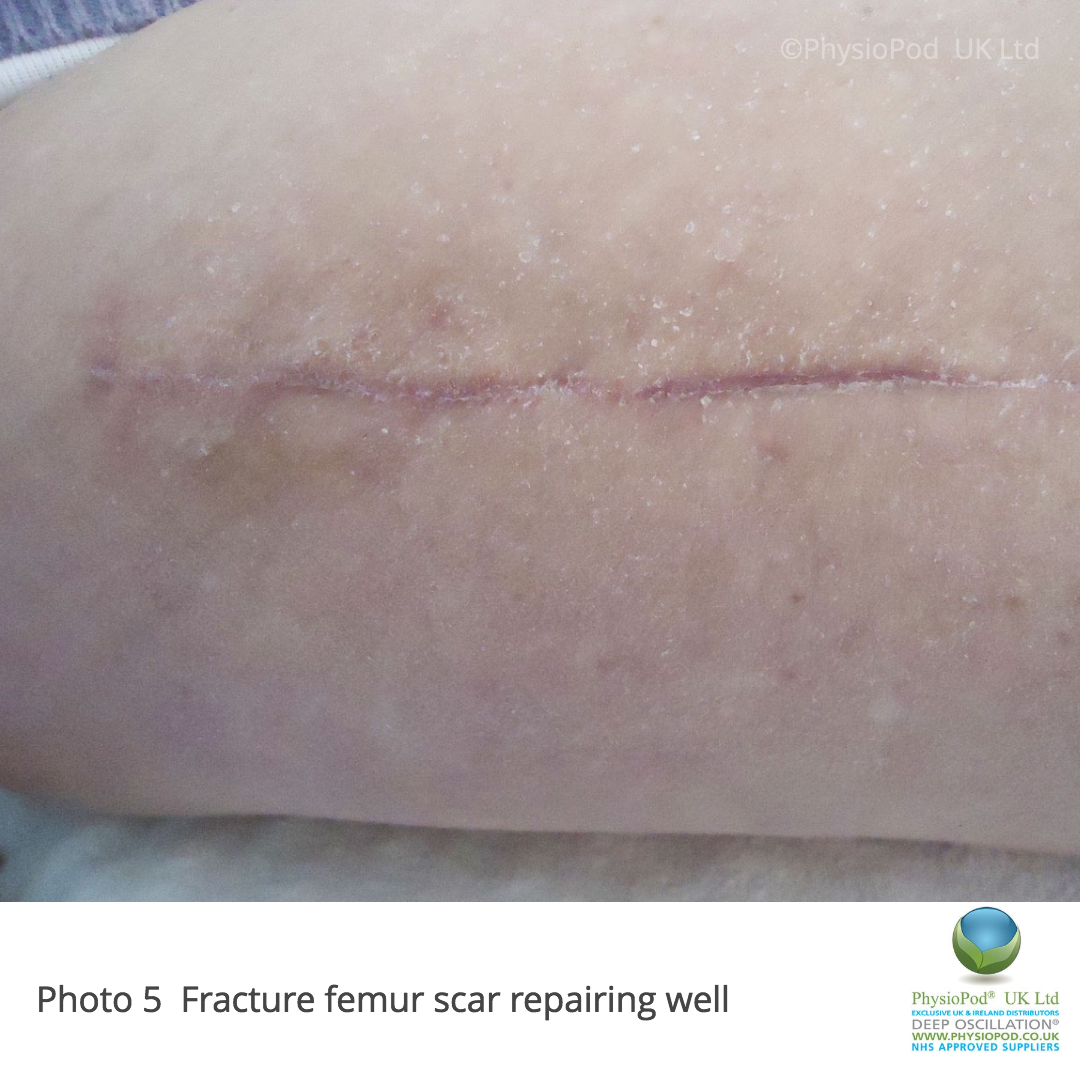
At Mrs P’s last visit, she arrived with no crutches and almost skipped in for her appointment. Deep Oscillation was applied comprehensively over and around the ulcer and deep into the Achilles with much greater tolerance, no ulcer dressing was required. The right femur looked amazing and the long scar had all but faded. Mrs P’s general mobility was excellent and she plans to return to driving very soon.
Practitioner’s Conclusion:
Mrs P was and is a very compliant patient being determined to try everything to aid all aspects of healing; recollections of her previous experience of a leg ulcer were not good taking ages to finally disappear. I feel she was very fortunate her sister remembered when she was a Practice Manager at a local Chiropractic Clinic where I was working, that a long standing patient to the clinic had horrific bilateral leg ulcers being treated for six years. He asked to see me and with the wonders of Deep Oscillation they healed in about eighteen months. Had there not been this connection, it is alarming to think Mrs P could be facing a foreseeable future of dependence and disability with a non resolving ulcer, muscle weakness and chronic pain. We joke but I think it is a good idea, Mrs P purchases some shin pads to be worn when gardening to protect her ankles from ‘stick hazards’.
Christine Talbot
SRN BLS MLD UK, Vodder, Leduc, LTA Fill & Flush, Casley Smith MLD DLT Practitioner and Lymphoedema Bowen Practitioners. BA Member.
Stoborough Meadow
Wareham Dorset
BH20 5HR
Telephone 01929 556560
Mobile 07881 598 937
VIEW PREVIOUS WOUND HEALING CASE STUDY
Magcell® References
Hitrov N.A., Portnov V.V. (2008): MAGCELL® ARTHRO in der Behandlung von Arthrose im Kniegelenk. Die Naturheilkunde 3, 25-27. - English translation (Hitrov N.A., Portnov V.V. (2008): MAGCELL® ARTHRO in the treatment of osteoarthritis of the knee joint. Naturopathy 3, 25-27.)
Reimschüssel A., Bodenburg P. (2009): Niederfrequente elektromagnetische Felder. Erfolgreich in der Therapie der Myoarthritis des Kiefergelenkes. Die Naturheilkunde 5, 28. - English translation: Reimschüssel A., Bodenburg P. (2009): Low-frequency electromagnetic fields. Successful in the therapy of myoarthritis of the temporomandibular joint. Naturopathy 5, 28.
Laser References
Mosca, R. C., et al. (2019). "Photobiomodulation Therapy for Wound Care: A Potent, Noninvasive, Photoceutical Approach." Adv Skin Wound Care 32(4): 157-167.
Machado, R. S., et al. (2017). "Low-level laser therapy in the treatment of pressure ulcers: systematic review." Lasers Med Sci 32(4): 937-944.
Tchanque-Fossuo, C. N., et al. (2016). "A systematic review of low-level light therapy for treatment of diabetic foot ulcer." Wound Repair Regen 24(2): 418-426.
Kuffler, D. P. (2016). "Photobiomodulation in promoting wound healing: a review." Regen Med 11(1): 107-122.
DEEP OSCILLATION References
https://www.physiopod.co.uk/references.shtml

